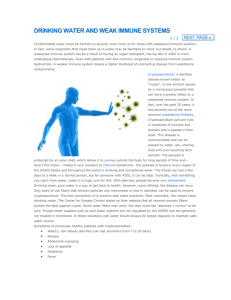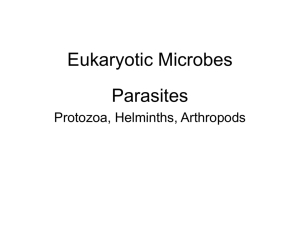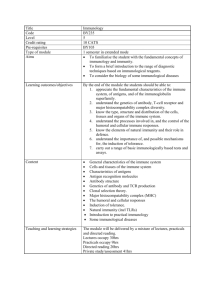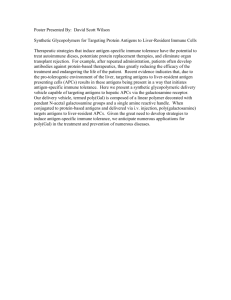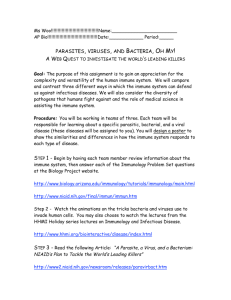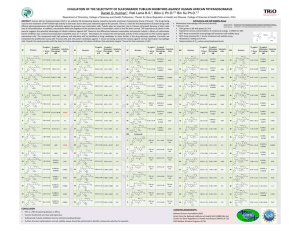Bauman Chapter 1 Answers to Critical Thinking Questions
advertisement
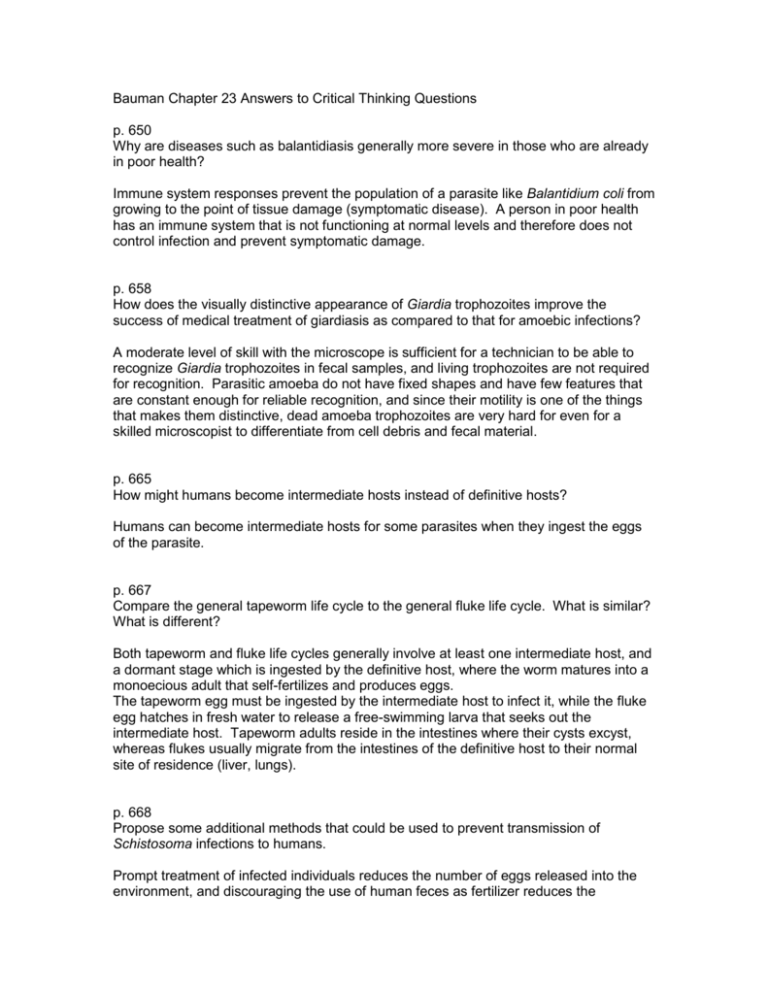
Bauman Chapter 23 Answers to Critical Thinking Questions p. 650 Why are diseases such as balantidiasis generally more severe in those who are already in poor health? Immune system responses prevent the population of a parasite like Balantidium coli from growing to the point of tissue damage (symptomatic disease). A person in poor health has an immune system that is not functioning at normal levels and therefore does not control infection and prevent symptomatic damage. p. 658 How does the visually distinctive appearance of Giardia trophozoites improve the success of medical treatment of giardiasis as compared to that for amoebic infections? A moderate level of skill with the microscope is sufficient for a technician to be able to recognize Giardia trophozoites in fecal samples, and living trophozoites are not required for recognition. Parasitic amoeba do not have fixed shapes and have few features that are constant enough for reliable recognition, and since their motility is one of the things that makes them distinctive, dead amoeba trophozoites are very hard for even for a skilled microscopist to differentiate from cell debris and fecal material. p. 665 How might humans become intermediate hosts instead of definitive hosts? Humans can become intermediate hosts for some parasites when they ingest the eggs of the parasite. p. 667 Compare the general tapeworm life cycle to the general fluke life cycle. What is similar? What is different? Both tapeworm and fluke life cycles generally involve at least one intermediate host, and a dormant stage which is ingested by the definitive host, where the worm matures into a monoecious adult that self-fertilizes and produces eggs. The tapeworm egg must be ingested by the intermediate host to infect it, while the fluke egg hatches in fresh water to release a free-swimming larva that seeks out the intermediate host. Tapeworm adults reside in the intestines where their cysts excyst, whereas flukes usually migrate from the intestines of the definitive host to their normal site of residence (liver, lungs). p. 668 Propose some additional methods that could be used to prevent transmission of Schistosoma infections to humans. Prompt treatment of infected individuals reduces the number of eggs released into the environment, and discouraging the use of human feces as fertilizer reduces the contamination of bodies of fresh water. Treating bodies of water near human habitation with chemicals to kill the snail intermediate stops the development of the parasite, but since this may result in unacceptable damage to ecosystems, it should only be considered for manmade ponds and rice paddies. Development of a chemical that is specifically toxic to the miracidium and can safely be distributed in water is a less damaging alternative to killing the intermediate host. p. 669 Thoroughly cooking raw vegetables prior to consumption would kill the metacercariae of Fasciola and prevent infection. Why is this method of prevention not practical? Cooking is not practical for some of the vegetables that Fasciola metacercariae may be found on (water cress, lettuce) because thorough cooking makes the vegetable unpalatable. p. 678 1. Compare Entamoeba, Acanthamoeba, and Naegleria. Based on incidence, which of these parasites is a threat to more people? Clinically, which is the most serious? Explain why your answer is not the same for both questions. Entamoeba is a global parasite of humans that can be carried asymptomatically and spread easily by the fecal-oral route and thus threatens more people than the other two amoebae. Naegleria is the most serious of the three pathogenic amoebae. Acanthamoeba and Naegleria are accidental parasites. Acanthamoeba causes keratitis and other localized infections in healthy individuals, and generally causes more serious neurologic disease in immunocompromised persons. In addition, Acanthamoeba encephalitis lasts weeks, making it possible to diagnose and treat the disease before it is fatal. Naegleria causes difficult to treat, usually fatal neurologic infections in otherwise healthy persons and disease progresses so rapidly that a patient may die before a diagnosis is made and treatment begun. Fortunately, intranasal inoculation (necessary for infection) with Naegleria is rare. 2. Explain how each of the following could lead to the reemergence of malaria in the United States: (a) global warming, (b) increased travel of individuals from endemic regions to the United States, (c) increased immigration of individuals from endemic regions to the United States, (d) regulations against the use of insecticides, and (e) laws protecting wetlands. Global warming results in the mild winter weather necessary for the survival of mosquito vectors of malaria becoming more widespread in US territory. Increased travel or immigration of people from endemic areas to the U. S. increases the number of imported cases of malaria, thereby increasing the odds of the U. S. mosquito population becoming infected with Plasmodium. Restrictions on the use of pesticides make mosquito population control more difficult, and protecting the wetlands increases the extent of potential breeding sites for the mosquitoes. 3. People who suffer from AIDS are severely immunocompromised because HIV destroys immune cells. Thus all the diseases in this chapter could be a threat to an AUDS patient. Which ones, however, would specifically exacerbate the immune dysfunction of AIDS? Why? In Chagas’ disease and leshmaniasis macrophages are infected and destroyed, exacerbating immune dysfunction. Chagas’ disease and African sleeping sickness, which are both cause by trypanosomes, are caused by parasites capable of changing surface antigens, resulting in the immune system continuously functioning at a high level of activity, which increases the rate of damage by HIV. Lymphatic filariasis (Wuchereria) results when nematodes take up residence in lymph nodes, impairing the function of the nodes and reducing immune function, although not as severely as when leukocytes are directly killed. 4. Discuss why sickle-cell trait is advantageous to people living in malaria endemic areas, but is not advantageous in malaria-free areas. The red blood cells of a person with the sickle-cell trait contain a form of hemoglobin that makes the RBCs resistant to infection by Plasmodium, thereby reducing the severity of malaria. The sickle-cell trait also causes RBCs to take on an abnormal (“sickle”) shape that makes the cells both fragile and likely to get stuck in capillaries. Where malaria is endemic the increased resistance increases a person’s survival, but in the absence of the selective pressure of malaria, damage to RBCs and blood vessels damages a patient’s health. 5. Present a logical argument to explain the differences between the clinical manifestations of Trypanosoma brucei and T. cruzi. Relate your argument to the respective life cycles. Trypanosoma brucei resides in the fluid compartments of the body (blood, lymph and eventually cerebrospinal fluid): the early symptoms are the result of immune responses to the antigens in the blood and lymph, and then inflammation of the brain when T. brucei has invaded the central nervous system. T. cruzi is an intracellular parasite that invades a variety of cell types, so the immune response is directed against infected cells and damaged tissues, a fundamentally different response than that directed against antigen in body fluids. 6. What feature of the life cycle of T. brucei makes it difficult to create a successful vaccine? Trypanosoma brucei is capable of changing at frequent intervals between a large number of possible variations of the antigens on its cell surface. The antigens are distinct enough that antibodies to one are not effective against the others. A vaccine against T. brucei is difficult to develop because a vaccine against so many antigens is not feasible.





